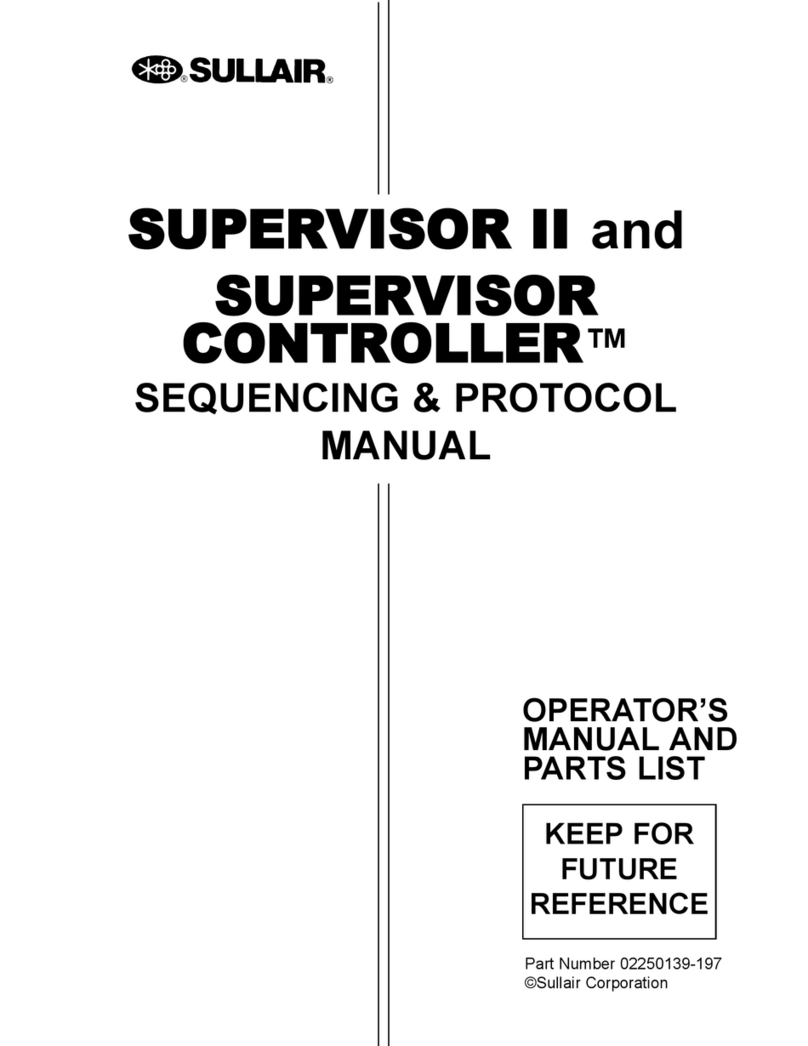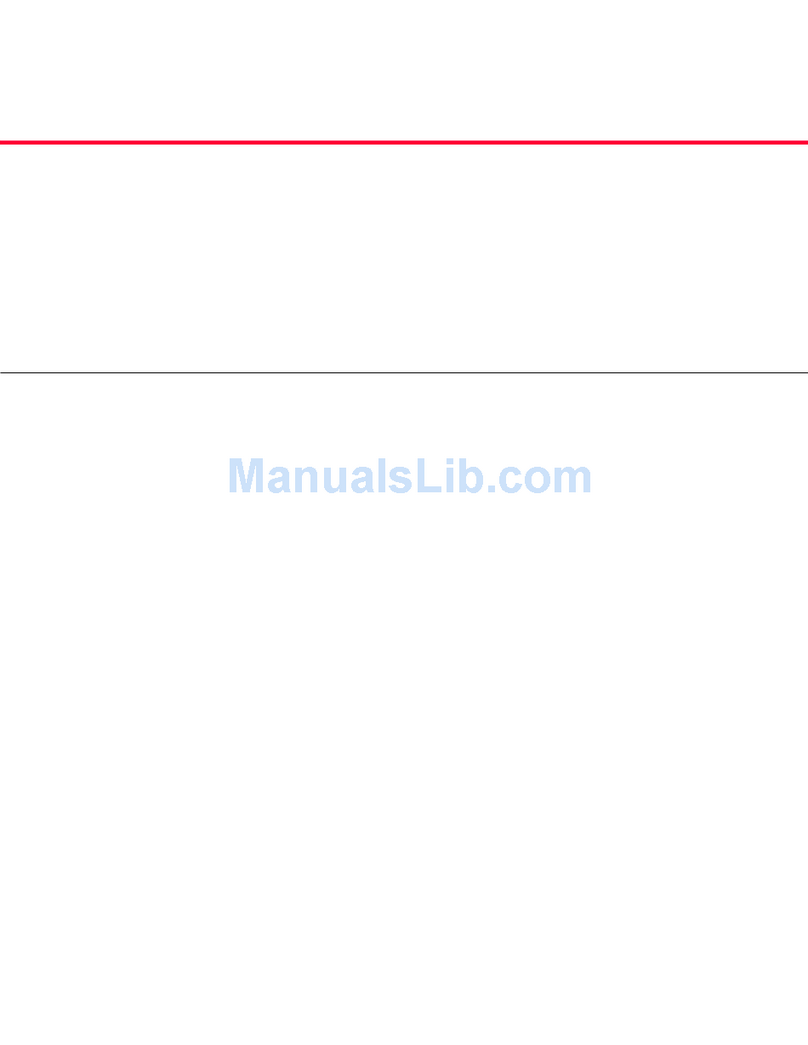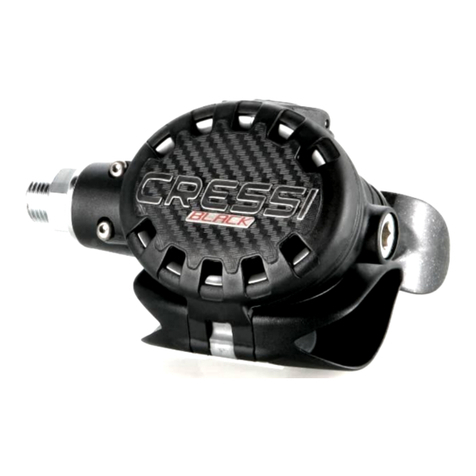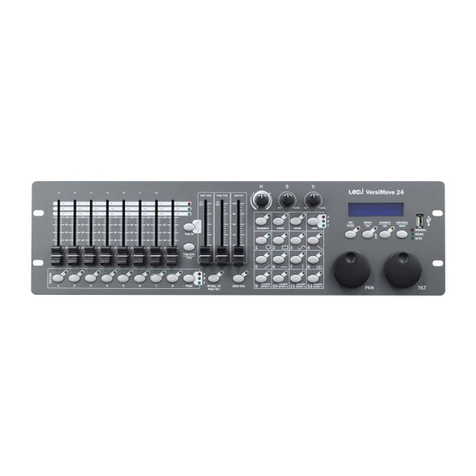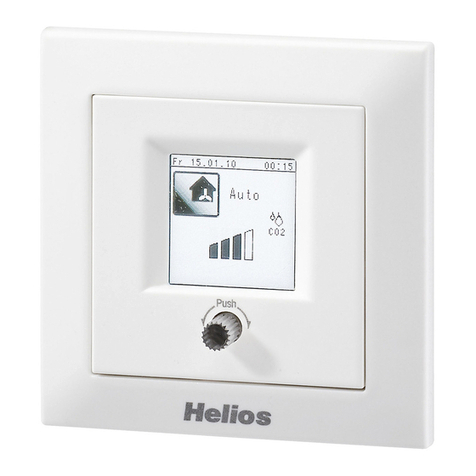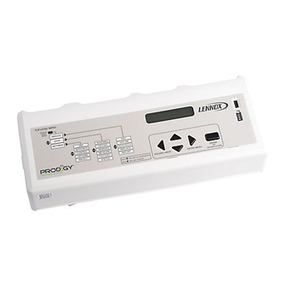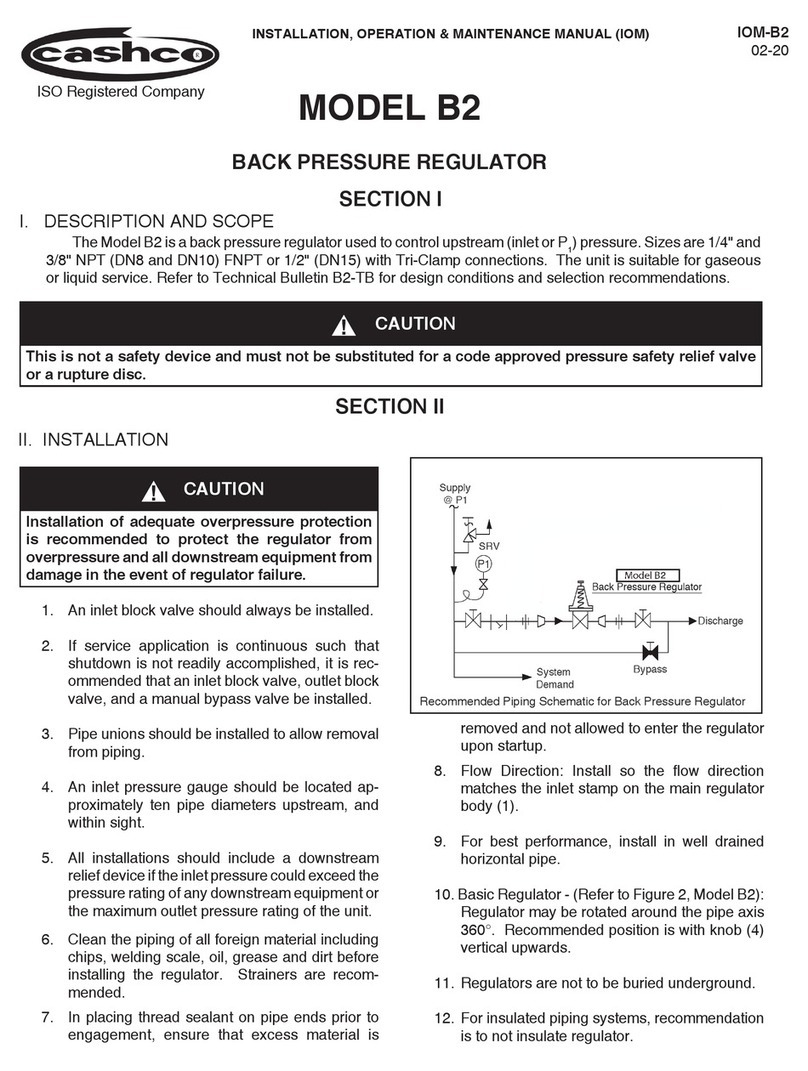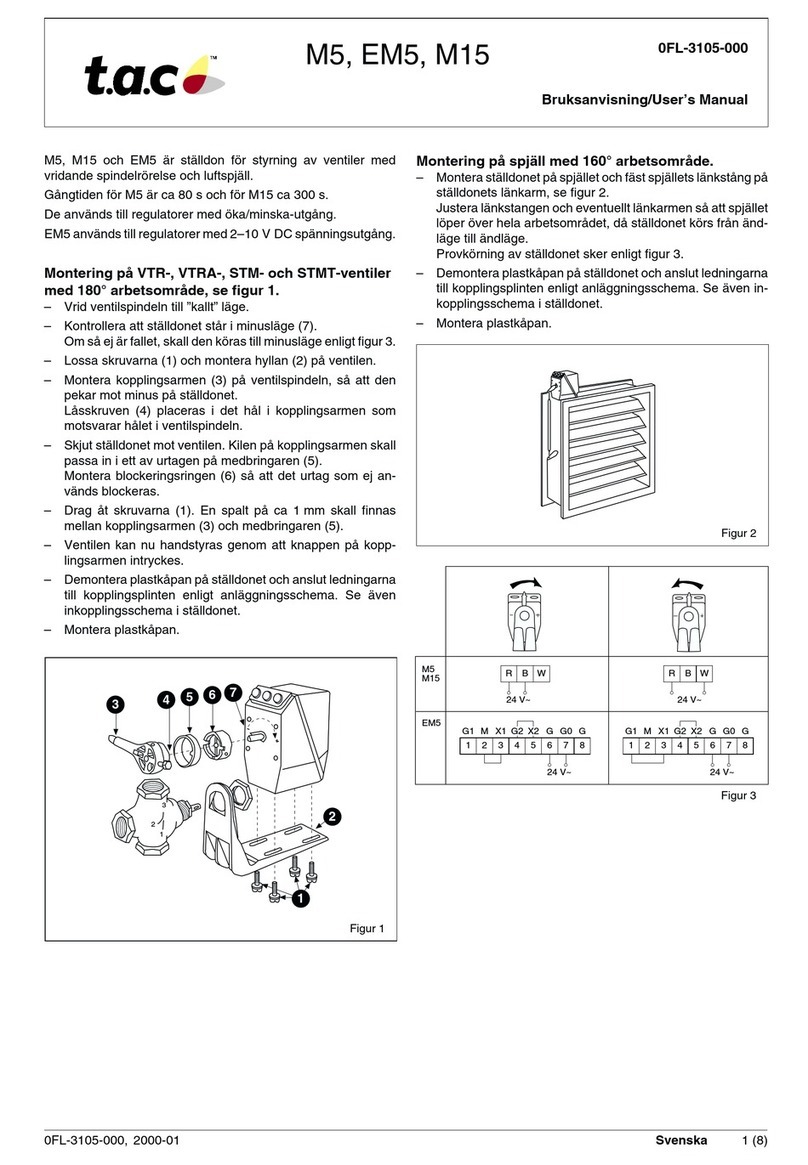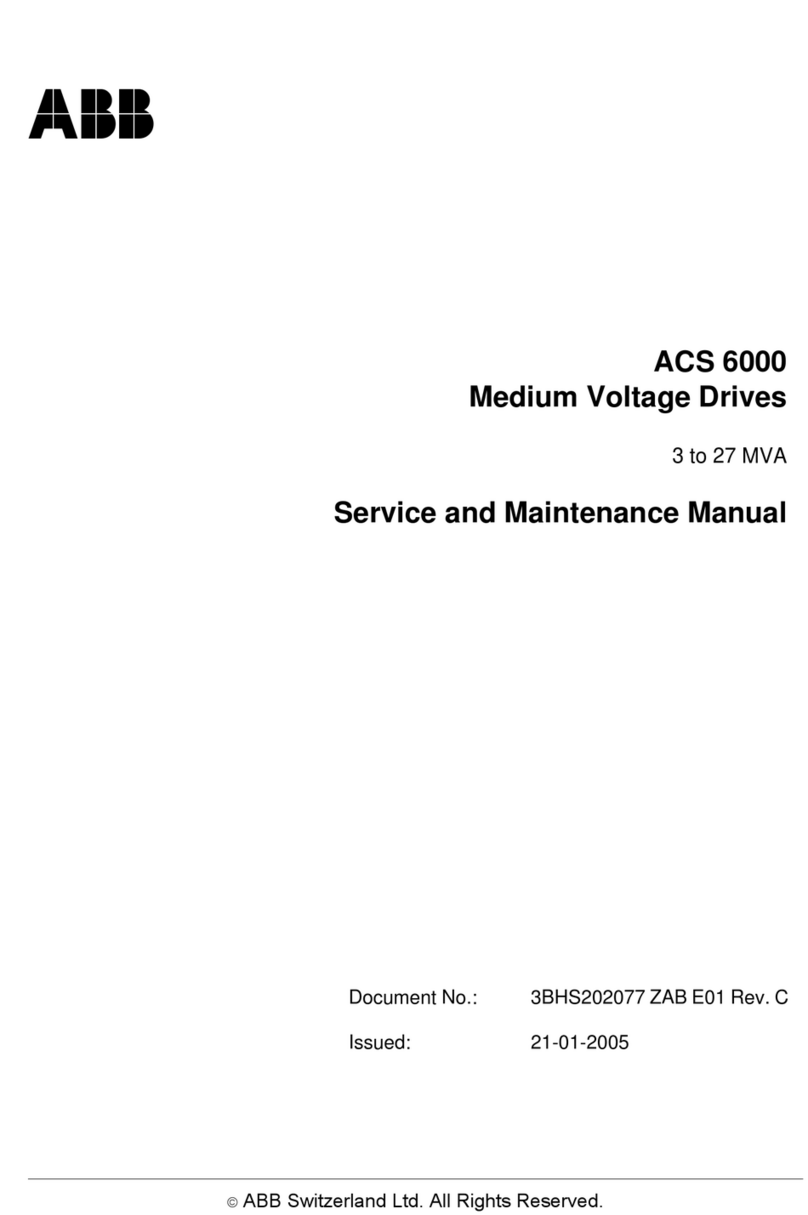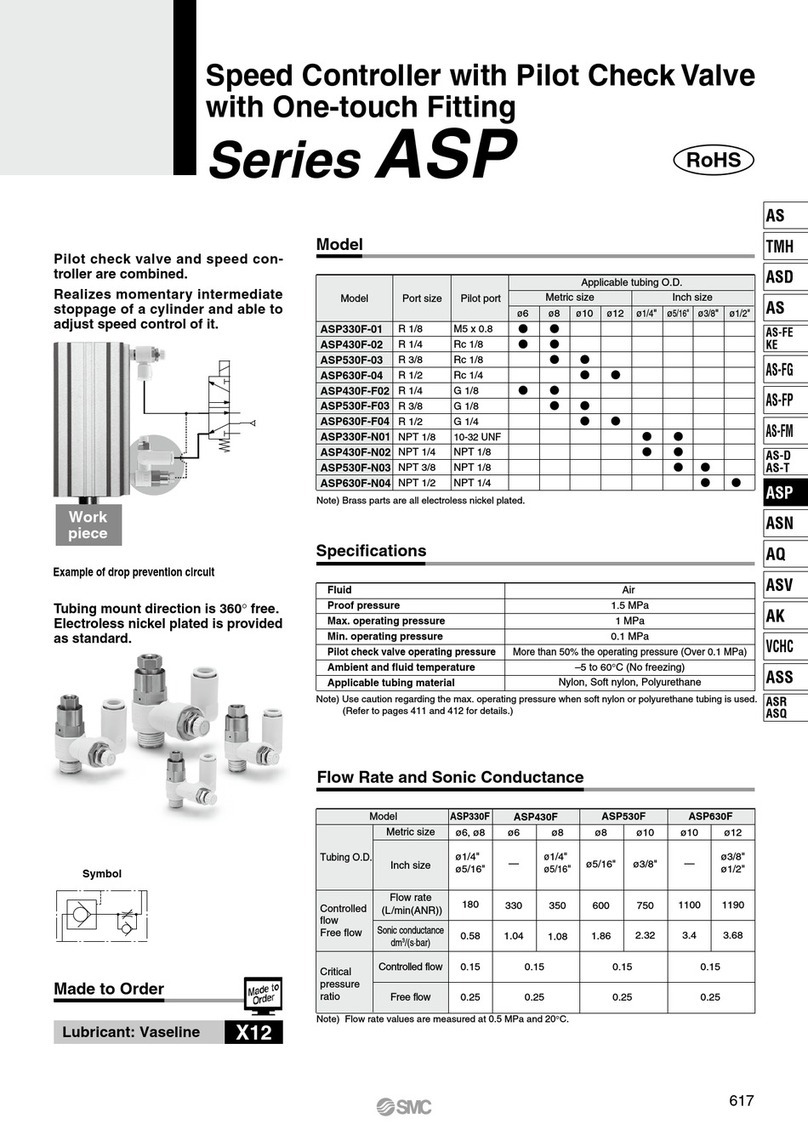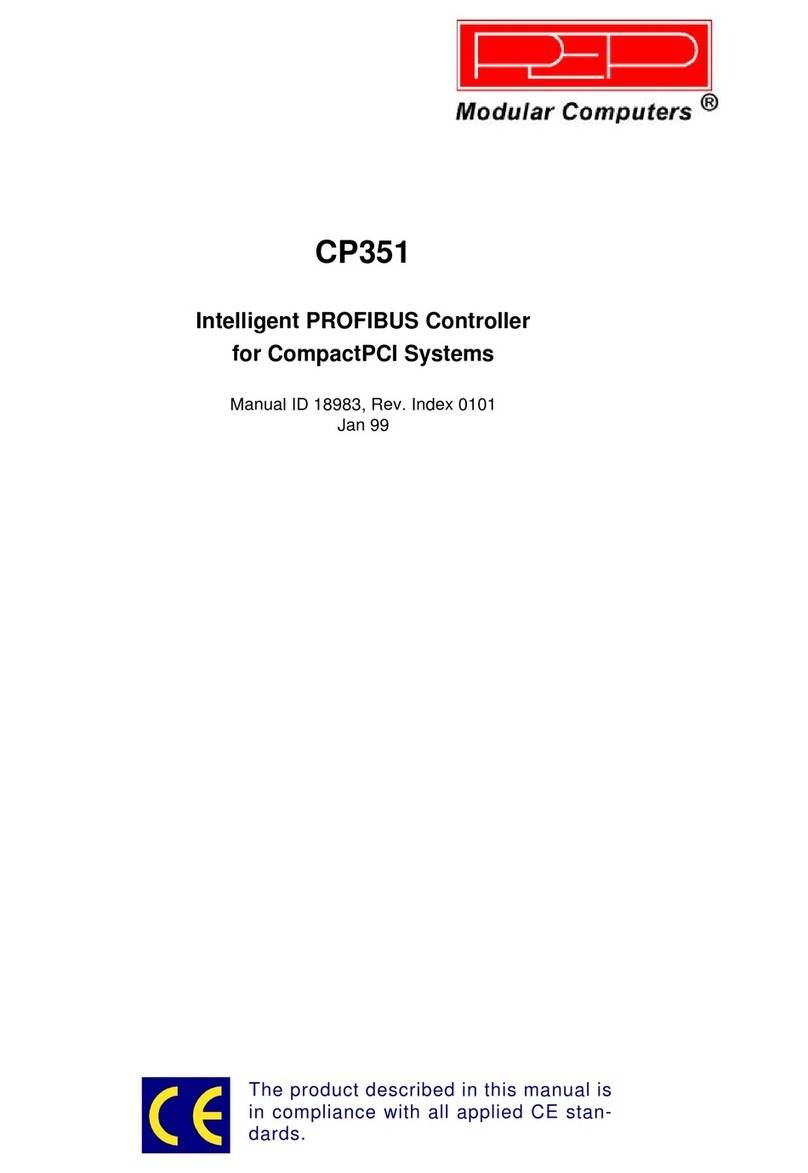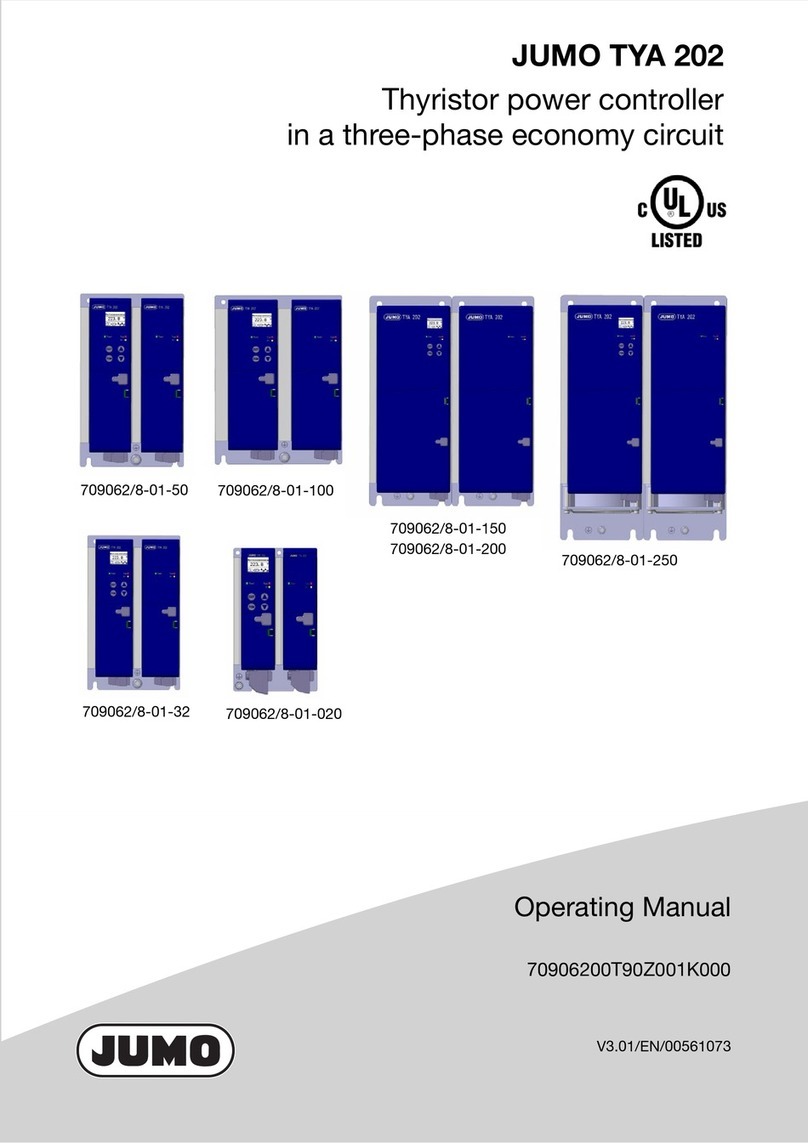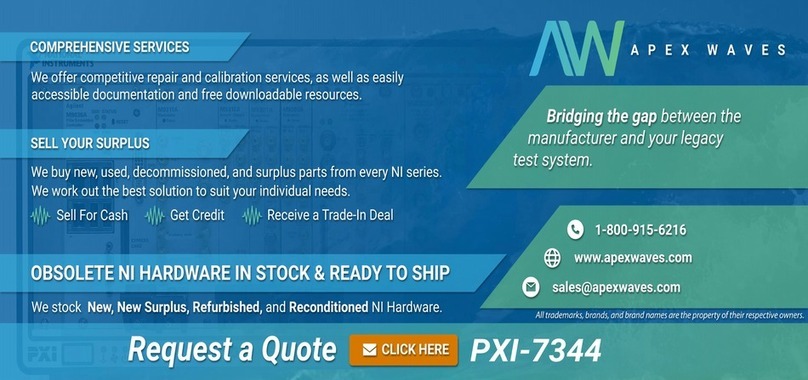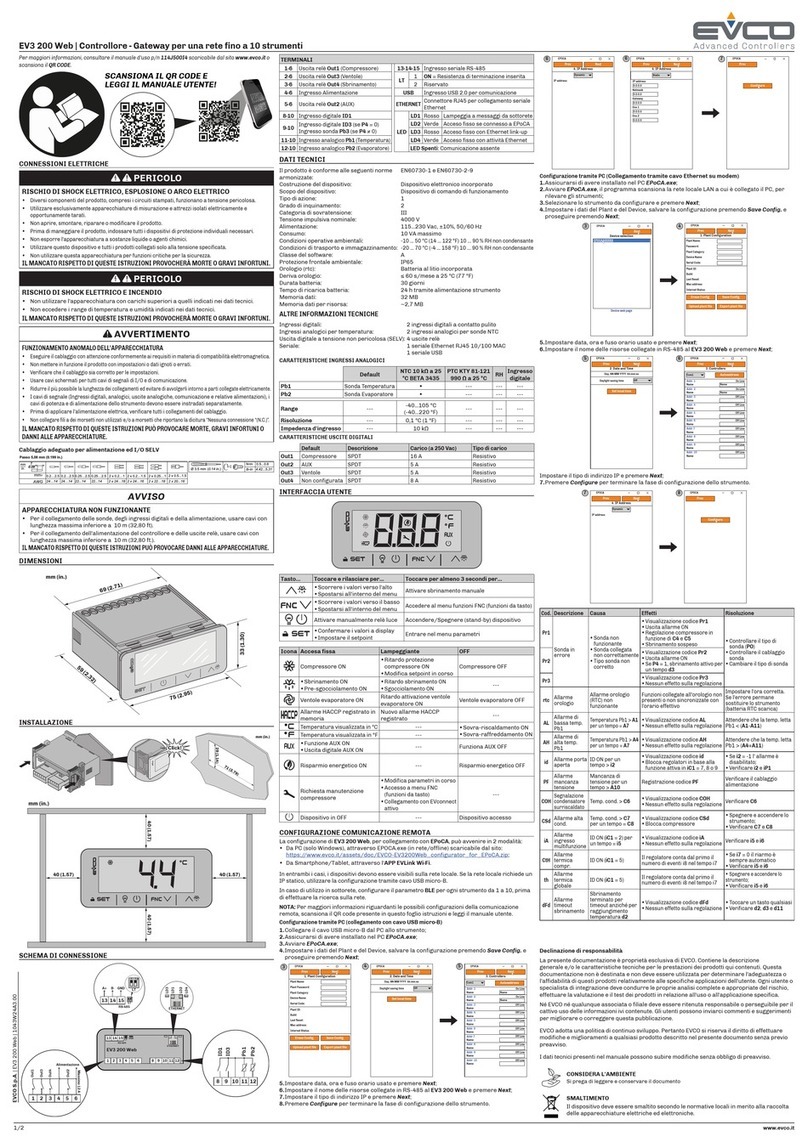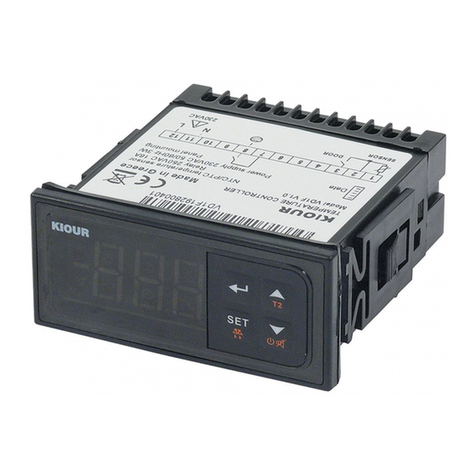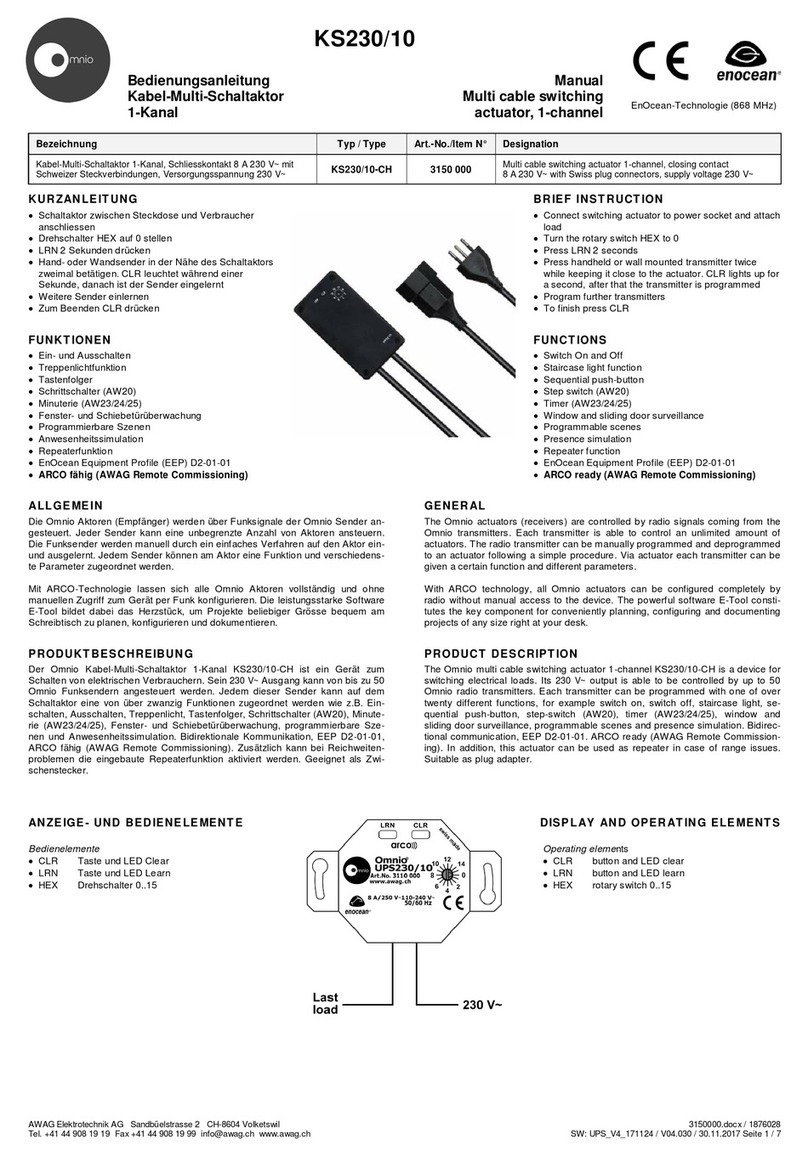Sullair SUPERVISOR CONTROLLER User manual

SUPERVISOR CONTROLLER™
and WS CONTROLLER
SEQUENCING & PROTOCOL MANUAL
(Including Supervisor II Deluxe Controller™)
INSTRUCTION
MANUAL
Part Number
02250161-162
©Sullair Corporation
KEEP FOR
FUTURE
REFERENCE

AIR CARE SEMINAR
TRAINING
Sullair Air Care Seminars are courses that provide hands-on instruction in the proper operation, maintenance
and service of Sullair equipment. Individual seminars on Industrial compressors and compressor electrical
systems are presented at regular intervals throughout the year at a dedicated training facility at Sullair’s
corporate headquarters in Michigan City, Indiana.
Instruction includes discussion of the function and installation of Sullair service parts, troubleshooting of the
most common problems, and actual equipment operation. The seminars are recommended for maintenance
and service personnel.
For detailed course outlines, schedule and cost information contact:
Sullair Corporate Training Department
1-888-SULLAIR or 219-879-5451 (ext. 5363)
www.sullair.com
Or Write -
Sullair Corporation
3700 E. Michigan Blvd.
Michigan City, IN 46360
Attn: Service Training Department

TABLE OF CONTENTS
1. SAFETY AND INTRODUCTION 1
1.1 SAFETY 1
1.2 SUPERVISOR CONTROLLER, SUPERVISOR II AND WS CONTROLLERS 1
1.3 SEQUENCED COMPRESSOR SYSTEMS 1
2. SEQUENCING WITH MULTIPLE CONTROLLERS 3
2.1 NORMAL OPERATION 3
2.2 COMPRESSOR SYSTEM 3
2.3 WIRING AND PIPING 4
2.4 MACHINE PREPARATION PRIOR TO SEQUENCING 4
2.5 SYSTEM OPERATION 5
2.6 SYSTEM SETUP AND TUNING 6
2.6.1 GENERAL SEQUENCING RULES 7
2.7 CHANGING SEQUENCE PARAMETERS 7
2.8 SEQUENCE PARAMETER NAMES 8
2.9 SYSTEM DISPLAY- SUPERVISOR CONTROLLER 10
2.10 SYSTEM DISPLAY- SUPERVISOR II DELUXE 10
2.11 SYSTEM DISPLAY- WS CONTROLLER 11
2.12 REMOVING A MACHINE FROM SEQUENCE FOR MAINTENANCE 11
2.13 CALIBRATION OF P2 PRESSURE TRANSDUCERS 12
2.13.1 SUPERVISOR P2 PRESSURE TRANSDUCER CALIBRATION 12
2.13.2 SUPERVISOR II DELUXE P2 PRESSURE TRANSDUCER CALIBRATION 13
2.13.3 WS CONTROLLER P2 PRESSURE TRANSDUCER CALIBRATION 13
2.14 FULL LOAD FEATURE 13
3. SEQUENCING WITH VARIABLE SPEED DRIVE COMPRESSORS 15
3.1 VARIABLE SPEED DRIVE APPLICATIONS 15
3.2 SETUP FOR FIXED SPEED MACHINES AND A VSD COMPRESSOR 15
3.3 SETUP FOR MULTIPLE VSD COMPRESSORS 16
4. OPERATION WITH REMOTE CONTROLLERS 17
4.1 NORMAL OPERATION 17
4.2 CONTROLS WIRING AND ADJUSTMENT – SUPERVISOR CONTROLLER 17
4.3 CONTROLS WIRING AND ADJUSTMENT – SUPERVISOR II DELUXE 18
4.4 CONTROLS WIRING AND ADJUSTMENT – WS CONTROLLER 19
OPERATOR IS REQUIRED TO READ
ENTIRE INSTRUCTION MANUAL
Continued

TABLE OF CONTENTS
5. SEQUENCING TIMERS FOR EFFICIENT OPERATION 21
5.1 RECOVERY TIME AND DELAYED START TIMER 21
5.2 TIMER OPERATION EXAMPLES 22
5.2.1 EXAMPLE 1– UNLOAD OPERATION 22
5.2.2 EXAMPLE 2– LOAD OPERATION 22
5.2.3 EXAMPLE 3– STARTING EXAMPLE 23
5.2.4 EXAMPLE 4– STARTING EXAMPLE 23
5.3 SEQUENCING TIMERS SUMMARY 24
6. CONTROLLER COMMUNICATION PROTOCOL 25
6.1 RECOVERY TIME AND DELAYED START TIMER - OVERVIEW 25
6.2 ADVANTAGES OF BROADCAST MODE 25
6.3 RS-485 SERIAL CHANNEL 26
6.4 TIME SLICING OF THE RS-485 SERIAL CHANNEL 26
6.5 MESSAGE FORMAT 27
6.6 MESSAGE TYPES 27
6.7 DATA TYPES 29
TELEPHONES, FAX AND ADDRESSES BACK COVER

Section 1
SAFETY AND
INTRODUCTION
1
1. SAFETY AND INTRODUCTION
1.1 SAFETY
1.2 SUPERVISOR CONTROLLER, SUPERVISOR II AND WS CONTROLLERS
This manual describes sequencing of multiple compressors with Supervisor Controller,
Supervisor II Deluxe or WS Controller. The term "controller" is used to apply to any of
the three devices, however, specific differences will be highlighted in the places where
they apply. Although each controller differs considerably in individual compressor
functions and user interface, they behave similarly in sequence capabilities. Any of the
controllers can be mixed within a compressed air system consisting of multiple machines.
Refer to the specific controller instruction manual for details on compressor operation and
adjustment of the controller.
1.3 SEQUENCED COMPRESSOR SYSTEMS
Compressor sequencing refers to using multiple compressors to meet the demands for
compressed air. This may be a simple duplex system or may consist of multiple
compressors used in applications with widely varying demands. The main concept for all
configurations is for the compressors to operate automatically when compressed air is
needed and to automatically stop if not needed. A properly designed system can offer
substantial reductions in operating cost over a single large compressor.
Many duplex systems are designed with one primary compressor accompanied by one
spare compressor. This configuration allows the system to remain operational during
maintenance of a machine. The controller efficiently runs the compressors to meet the
varying demands during the day and runs the backup compressor only when needed.
The Supervisor, Supervisor II Deluxe, and WS Controllers all feature internal sequencing
functions. The Supervisor Controller requires a separate communications module for
these features. The machines operate as a distributed control system (rather than a
The Operator should be familiar with all safety measures as described in the
Supervisor Controller, Supervisor II Deluxe, or WS Controller Instruction
manuals
(
whichever
p
ertains
)
.
Machines should be off-line and not running when making parameter changes.
Unexpected machine operation may occur.
NOTE
For information specific to the Supervisor Controller, Supervisor II Deluxe, o
r
WS Controller, consult the Instruction Manual for that specific controlle
r
model.

Section 1
SAFETY AND
INTRODUCTION
2
master-slave relationship) so the system remains operational even if a member is taken
off-line. Both the Supervisor Controller and WS Controller can be configured with up to
16 machines in a sequence system. When one or more Supervisor II Deluxe Controllers
are in the system, the maximum number of machines is eight. Refer to Section 2 for
details.
A system with one or more variable-speed compressors offers additional opportunities for
control. Refer to Section 3 for details on sequencing with variable speed compressors.
Section 4 covers application of controllers in master-controlled systems.
Section 5 describes the operation of timers used in an internal sequencing system.
Section 6 contains technical details of the hardware and protocol used on the
communication bus. Other equipment may monitor the communication bus for data and
assessment of system performance.

Section 2
SEQUENCING WITH
MULTIPLE CONTROLLERS
3
2. SEQUENCING WITH MULTIPLE CONTROLLERS
2.1 NORMAL OPERATION
The Supervisor, Supervisor II Deluxe, and WS Controllers all feature internal functions
that enable sequencing of multiple machines.
•To enable a Supervisor Controller in the system, press the START pad and
REMOTE pad on the keypad.
•Enable the Supervisor II Deluxe by simply pressing the AUTO pad.
•Enable the WS Controller by simply pressing the START pad .
•Stop any individual compressor by pressing the STOP pad for that unit. The
remaining compressors will continue to operate as needed.
The Supervisor Controller has a Remote keypad on the display module that is used to
enable and disable the controller from any sequencing mode currently programmed.
When the Remote key is first pressed after sequencing has been programmed, the
sequencing mode will be enabled and the REMOTE LED on the Display Module will
illuminate. Pressing the Remote keypad again will turn off the LED and disable the
sequencing mode. The compressor will then operate as though it is not in any
sequencing mode. The process will be reversed when the Remote keypad is pressed
again.
2.2 COMPRESSOR SYSTEM
Internal controller sequencing is designed to operate a group of (2-16) compressors
feeding a common header. As air demands change, the compressors will be controlled
to deliver the required compressed air in an efficient manner. If a group of similar
compressors is used, the controllers can be set up to automatically rotate operation to
equalize run time. The controllers can also be configured for a desired order of
compressor operation. The three modes of sequencing operation are described below:
SEQUENCE HOURS - The order a compressor is set to run in a sequence operation
based on the machine’s sequence hours. In this mode, machines are started and
loaded depending on the SEQUENCE HOURS (Seq. Hrs) parameter. Typically the
machine with the next lowest number of sequence hours will be the next in sequence to
start and load. The sequence hours parameter is similar to run hours except that it can
be changed. A machine taken out of sequence will be skipped and the machine with
the next lowest number of hours in the sequence will be next to start and load. While
Sequence Hours mode is active, digital inputs for Remote control are disabled and
Rotate hours function is disabled.
COM NUM - In this mode, a machine is started and loaded depending on the
COMMUNICATION NUMBER parameter assigned to the machine. Operation is
exactly the same as the SEQUENCE HOURS method (see above) except the
communications number is used to determine machine sequence instead of sequence
hours. Typically, the machine having a com number that is one number higher than the
previous started machine will be the next to start and load. A machine taken out of
sequence will be skipped and the machine with the next consecutive comm number in
the sequence will be next to start and load. Digital inputs for Remote control are
disabled.
SEQUENCE HOURS with ROTATE Hours Enabled – This SEQUENCE hours
configuration applies only to two-machine applications that supply a demand for only

Section 2
SEQUENCING WITH
MULTIPLE CONTROLLERS
4
one machine. DO NOT enable this mode in systems with more than two machines
(See ROTATE hours parameter setting for more information). Digital inputs for remote
control are disabled.
2.3 WIRING AND PIPING
Control signals are passed along a simple network cable, Belden 9842 or similar. This
cable has two twisted pairs with a shield. Twisted pairs usually have one color coded
wire twisted with a black or white wire.
For Supervisor Controllers, one twisted pair is connected to ISO+ and ISO- on the
Supervisor Comm module. Make sure that the color coded wire is connected at ISO+
and the white or black wire is connected at ISO-. Both wires of the other twisted pair
must be connected to ISO GND. The wire shield must be connected to ground at one
end only.
For Supervisor II Deluxe Controllers, the color coded wire is to be connected to J2-16
and the white or black wire to J2-17. Both wires of the other twisted pair are to be
connected to J2-18.
For WS Controllers, connections may be made to either J11 or J12. The color coded
wire is connected to PF 485+ and the white or black wire connects to PF 485-. Both wires
of the other twisted pair are to be connected to PF 485C.
For the most efficient operation in a sequential system, the P2 (line pressure) transducers
of all machines should be connected to a common header, down stream of individual
dryers, etc. Note that the dP1 (separator maintenance delta pressure) may need to be
calibrated to take into account the extra pressure drop of the down stream equipment.
Refer to Section 2.13 for steps on calibrating the system pressure readings.
2.4 MACHINE PREPARATION PRIOR TO SEQUENCING
For each machine to be connected in the sequence:
1. Complete all machine startup procedures as required for stand-alone operation.
Refer to the specific compressor operator and controller manual for each machine.
2. Calibrate the P2 signal for all machines to read the same pressure at the common
header. Each controller must be calibrated to read the same P2 pressure (±1 psi) of
the common header psi.
If necessary, recalibrate the P2 signal for each controller in the system. Refer to Section
2.13 for procedure on pressure calibration.
3. Program each machine with a different COM ID number (i.e.1, 2, 3, etc.).
4. Set the following parameters the same for each machine (except for VSD
applications).
DO NOT enable the Rotate Hours mode when the above situation is NOT true.
Unexpected starts and stops may occur when manually starting or stopping a
machine in the sequence.

Section 2
SEQUENCING WITH
MULTIPLE CONTROLLERS
5
a. UNLOAD psi
b. LOAD psi
c. BAUD RATE (Supervisor II only). Baud Rate for Supervisor and WS is fixed
at 9600.
d. SEQUENCE mode (COM ID or HOURS)
e. LAST COM
f. LOWEST (minimum pressure before a machine is started)
g. RECOVER time (normally set at 10)
h. Leave ROTATE hours disabled except for the specific application described
in Section 2.8.
i. Set all sequence hour parameters the same unless it is desired to force
certain machines to initially run longer than others in the HOURS mode.
5. Start the machines for sequencing as described in Section 2.1. Machines will start
immediately if the P2 system pressure is low. On a fully pressurized system the
machines will go into a standby state until a demand is recognized.
2.5 SYSTEM OPERATION
The following example describes how machines are started, fully loaded and unloaded by
the sequencing mode selected. The Automatic mode provides the means for each
machine to stop by timing out on its unload timer when the sequencing order indicates
the machine is to be unloaded.
For this example three machines are in a system with the load pressure set at 100,
unload limit pressure at 110 psig (7.6 bar), lowest pressure limit at 90 psig (6.2 bar), and
Recovery Time at 10 seconds (default value). All machines are stopped.
1. When the pressure drops below 102 psig (7.6 bar) a timer starts counting down from
120 seconds, if the pressure continues to drop the timer will count down faster
(increments will be shorter).
2. When the timer expires or the pressure drops below 90 psig (6.2 bar) the first (or
next) machine in the sequence is started.
3. If the pressure does not go above 90 psig (6.2 bar) for 10 seconds (Recovery Time)
the second (or next) machine in the sequence will start. This process will continue
until all machines are started or loaded.
4. As machines are started and loaded, there will be only one machine that is
modulating, the others will be forced to "FULL LOAD". The modulating (trim)
machine will load at 2 psig (0.14 bar) above the load pressure parameter, 102 psig
(7.03 bar) in this example, and unload at 2 psig (0.14 bar) below unload pressure
parameter, 108 psig (7.4 bar) in this example. The reason for this narrow
load/unload band is to keep all machines from loading and unloading at the same
time.
5. If the pressure rises above the unload pressure -2 psig (0.14 bar) to 108 psig (7.4
bar) the trim machine will unload (display will read "UNLOADED") and the next
machine in the sequence will switch from full load to trim.

Section 2
SEQUENCING WITH
MULTIPLE CONTROLLERS
6
6. If, after Recovery Time, the pressure is still above 108 psig (7.4 bar) then the
current trim machine will unload. This process can continue until all machines are
unloaded.
7. If the pressure falls below load pressure +2 psig (0.14 bar) or 102 psig (7.03 bar) the
first machine in the sequence will load and operate as the trim machine.
8. If after the Recovery Time the pressure is still below 102 psig (7.03 bar) then the
trim machine will go to full load and the next machine in the sequence will load and
become the trim machine.
2.6 SYSTEM SETUP AND TUNING
Table 2.1 lists settings for a system of low pressure (90-100 psig (6.2 to 6.9 bar))
machines used in a typical sequencing configuration. The Trim High & Low Setpoints are
not user settable parameters. These values are calculated from the Unload and Load
pressures. The Trim High Setpoint is 2 psi (0.14 bar) below the Unload pressure. The
Trim Low Setpoint is 2 psi (0.14 bar) above the Load pressure.
Table 2.1 Low Pressure Machine Settings (typical)
Machine Setting: Value
Unload Pressure 100 psig (6.9 bar)
Trim High Setpoint (calculated parameter) 98 psig (6.8 bar)
Trim Low Setpoint (calculated parameter) 92 psig (6.3 bar)
Load Pressure 90 psig (6.2 bar)
Lowest pressure 85 psig (5.9 bar)
Recover time (seconds) 10
Note that the unload pressure is set to 100 psi (6.9 bar) and not 110 psi (7.6 bar) as is
normal on a stand alone machine. A stand alone machine set up at 100 psi (6.9 bar) to
110 psi (7.6 bar), starts to modulate above 100 psi (6.9 bar) and the horsepower is
reduced. However, in a sequenced system a machine may be forced to full load, which
would draw more than the rated horsepower above 100 psi (6.9 bar). Therefore, the
modulation band of machines in a sequencing system should be set up to be 10 psi (0.7
bar) lower than their rated pressure.
All running machines in a sequence operate either at full load or unloaded except for one
which is operated as the trim machine. The trim machine unloads when the line pressure
rises above the Trim High setpoint.
Trim High and Trim Low setpoints signal the trim machine to unload before the fully
loaded machines and load before the unloaded machines. Otherwise, all machines
would load and unload at the same time.
LOWEST pressure parameter specifies the lowest pressure allowed before immediately
starting a machine. A machine may also be started if the line pressure drops below the
Trim Low setpoint for a determined period of time.
RECOVER time keeps multiple machines from loading, unloading or starting at the same
time. A timer is reset when a machine loads, unloads or loads after a start. Decisions to
load, unload or start another machine are deferred until the timer reaches the RECOVER

Section 2
SEQUENCING WITH
MULTIPLE CONTROLLERS
7
time setpoint. Note that the timer starts when a machine is added or taken away from the
system.
If the pressure recovers within the RECOVER time, and then at a later time the pressure
drops below the Trim Low setpoint, the next machine in sequence will load immediately.
The shorter the recovery time the more responsive the system to load changes.
However, the system would be less energy efficient with shorter recovery times since the
machines may not shut off as often. The more frequently a machine loads the less likely
it is to stay unloaded and shut off after the Unload timer expires. Refer to Section 5 for
details on Recovery Timers.
The RECOVER TIME has a default value of 10 seconds. This parameter may be
adjusted in one second intervals from 2 to 59 seconds.
2.6.1 GENERAL SEQUENCING RULES
The following rules apply to load, unload and start of machines in a sequence. Note that
the terms “highest” and “lowest” refer respectively to machines with the highest and
lowest SEQ HRS or COM ID.
Rule 1. Only the highest loaded machine will trim; the rest will be forced to full load.
Rule 2. The trim machine will unload when the line pressure rises above the Trim High
setpoint.
Rule 3. The next highest loaded machine will then become the trim machine. If
pressure remains above the Trim High setpoint, the new trim machine will
unload after Recovery Time expires. This process will continue until enough
machines are running and loaded to maintain proper system pressure.
Rule 4. The lowest unloaded machine will load (trim) when the line pressure drops
below the Trim Low setpoint. If the pressure remains below the Trim Low
setpoint the next Unloaded or Sequence Stopped machine will load or start
after the Recovery Timer expires. This process will continue until enough
machines are running and loaded to maintain proper system pressure.
Rule 5. The lowest stopped machine will start when the line pressure drops below the
Trim Low setpoint, and after a variable time out period (up to 120 sec.). This
time out is dependent on how far the line pressure is below the Trim Low
setpoint. The farther the line pressure is below the setpoint the shorter the
time to start.
Rule 6. The lowest stopped machine will override the above variable time out feature
and start when the line pressure drops below the Lowest Pressure setpoint,
and after the recovery timer expires.
2.7 CHANGING SEQUENCE PARAMETERS
Supervisor Sequence Parameters
Perform the following steps to change sequence parameter settings using the Supervisor
Controller:
1. Press the Down arrow key until the SEQUENCING menu is displayed.
2. Press Enter .
3. Use the Up and Down arrow keys to navigate through the menu selections to
the parameter to be edited.

Section 2
SEQUENCING WITH
MULTIPLE CONTROLLERS
8
4. Press Enter to select the parameter for editing.
5. If a numeric value is to be entered, Use the Right and Left arrow keys to
position the cursor over the number digit to be changed.
6. Use the Up and Down arrow keys to change the parameter value.
7. Press Enter to save the changed value.
Supervisor II Deluxe Sequence Parameters
Perform the following steps to change sequence parameter settings using the Supervisor
II Deluxe Controller:
1. Push the Program key until the top line of the display identifies the sequence
parameter to be changed.
2. Press the Up arrow and/or Logo keys to increment the sequence parameter
value or press the Down/Lamp Test key to decrement the value.
3. Push the Program key to save the changed value. The next sequence
parameter will then be displayed.
Changing Sequence Parameters – WS Controller
Refer to the WS Controller PC User Interface Manual for instructions on changing
sequence parameters. The following sequence parameters can be changed at the WS
PC User Interface:
PARAMETER OPTIONS
Sequence by.................Disabled, Remote, Slave, Hours, COM Number
Sequence hours............Integer value for sequence hours setting
Com number.................1 - 16
Machines.......................1 - 16
Low press (PSI)............30 psi - 248 psi
Recover time.................2 sec. - 60 sec.
Rotate ...........................Integer value for number of rotate hours
2.8 SEQUENCE PARAMETER NAMES
Listed below are names of Supervisor and WS Controller sequence parameters that can
be modified when sequencing is enabled. Supervisor II Deluxe sequence parameters are
shown in parenthesis with the numerical order in brackets. The WS Controller uses a PC
interface to modify parameter values.
Sequence by (SEQUENCE[9]) - Select the desired sequencing mode.
Sequence hours - The maximum value for sequence hours is 100,000. A rollover to
zero will occur if that number is exceeded.
(SEQ HRS[17]) - Pushing the Logo key will increment this value by 1000 hours, the
Up arrow key will increment by 100 hours and the Down/Lamp Test key will

Section 2
SEQUENCING WITH
MULTIPLE CONTROLLERS
9
decrement by 100 hours. The maximum value for this parameter is 30,000 hours. The
number will roll over to zero if this number is exceeded.
Com Number (COM ID#[7]) - Must be unique ID number for every machine in the
system. If there are three machines in a system, for example, they must be numbered 1,
2 and 3. Up to 16 machines may be sequenced in systems using Supervisor and WS
Controllers. Systems containing one or more Supervisor II Deluxe controllers are limited
to eight compressors in a sequence.
Machines (LAST COM[12]) - Set as the total number of machines in a system.
Low Press (LOWEST[13]) - Set as the lowest allowable pressure before a machine has
to start. Normally this is 5 to 10 psi (0.3 to 0.7 bar) below the load pressure. If the
system pressure drops below this limit then the machine with the lowest SEQ HRS or
COM ID is started immediately. A machine will also start if the pressure is below the Trim
Low Setpoint for a period of time. The length of this time period is 0 to 120 seconds
depending on the pressure and is controlled by the Delayed Start Timer. The closer the
pressure is to LOWEST pressure the shorter the time. For example if the pressure drops
below the Trim Low Setpoint by 1 psi (0.07 bar), and remains there, a machine will start
in 120 seconds. If the pressure drops near LOWEST PRESSURE then a machine will
start after just a few seconds. Refer to Section 5 for details on Delayed Start Timer
operation.
Recover Time (RECOVER[14]) - Recovery time. This parameter adds a delay between
subsequent start, load and unload commands. Refer to Section 5 for further explanation
of Sequencing Timer operation.
Rotate (ROTATE[15]) - Rotate time for two-machine systems only. The rotate parameter
forces the trim machine to stop (allowing the other machine to start). The trim machine
will stop when its sequencing hours are more than a stopped machine sequencing hours
based on the rotate hours value.
For example, consider a two-machine system with SEQUENCING hours of 1000 and
ROTATE of 50 hours on each machine. If one machine is started and continuously
loaded, it will run until it's sequence hours are 1050 (50 hours more than the stopped
machine) then stop. The other machine will start and run until it's sequence hours are
1100 (50 more than the stopped machine) then stop, and so the machine will rotate back
and forth every 100 hours.
DO NOT enable Rotate mode when more than two machines are connected in a
sequence. Unexpected starts and stops may occur when manually starting o
r
stopping a machine in the sequence for maintenance.
NOTE
There are some systems where the trim machine never unloads or stops and
the second machine is never required in normal sequence operation. This
applies specifically to a two-machine system where one machine runs all the
time and the other is used onl
y
for backu
p
.

Section 2
SEQUENCING WITH
MULTIPLE CONTROLLERS
10
(BAUD RATE[8]) – All controllers in a system must be set to the same Baud Rate. The
Supervisor and WS Controller baud rate is fixed at 9600 baud. The Supervisor II Deluxe
allows adjustment of the serial communications baud rate, usually set to 9600.
2.9 SYSTEM DISPLAY- SUPERVISOR CONTROLLER
The Supervisor Controller System Menu allows the user to observe the status of other
compressors in a sequence. The option is useful when monitoring, troubleshooting and
calibrating the compressor system. To access the System Menu and view the status of
the machines:
1. Press the up arrow until the word “SYSTEM” appears on the bottom line of the
display screen.
2. Press Enter.
3. Use the down and up arrows to scroll through the data relating to each machine
in the sequence.
Data for the machines will appear in five columns across the display screen. The first
column of the display shows the machine Comm numbers (#1 through the total number
of machines in the system) set by parameter LAST COM. The second column shows the
status (Stat) of each machine as noted in the following chart. The third column displays
the machine sequence hours (Hrs) parameter. The fourth column shows the Capacity
(Cap) at which the machine is delivering air. The heading of the fifth column displays the
highest P2 pressure in the system with the P2 pressure for each respective machine
displayed down the column. Status letters appearing in lower case indicate the machine
has a fault or warning.
The status letters that may appear on the Supervisor display are:
B – Standby R - Remote or sequence stop
E - E-Stop S - Starting
F - Full Load T - Trim (loaded and modulating)
L - Loaded U - Unloaded
M - Manual stop X - Remote Disable (WS Controller only)
2.10 SYSTEM DISPLAY- SUPERVISOR II DELUXE
The Supervisor II Deluxe SYSTEM menu allows the user to observe the status of other
compressors in a sequence. The option is useful when monitoring, troubleshooting and
calibrating the compressor system. To access the System Menu and view the status of
the machines in the sequence:
1. While in the main display, push the Logo key.
2. Press the “Display” ( ) key. The top line of the display will show the numbers 1
through the number of machines in the system (maximum of 8 for the Supervisor
II). The second line shows the status of each machine. Status letters in lower
case indicate the machine has a fault or warning.
The status letters that may appear on the Supervisor II Deluxe display are:
B – Standby R - Remote or sequence stop
E - E-Stop S - Starting

Section 2
SEQUENCING WITH
MULTIPLE CONTROLLERS
11
F - Full Load T - Trim (loaded and modulating)
L - Loaded U - Unloaded
M - Manual stop X - Remote Disable (WS Controller only)
If the Up arrow key is pushed the system line pressure is displayed. If the Up
arrow key is pushed again the line pressure and sequence hours of the first machine is
displayed. If the Up arrow key is pushed again, data for the next machine is
displayed. Subsequent press of the Up arrow key allows for viewing of data for each
machine in the system. A press of the Lamp Test key reverts back to the preceding
display.
2.11 SYSTEM DISPLAY- WS CONTROLLER
The system display for monitoring sequencing of WS Controllers is accessed via the WS
PC software program. Refer to the WS PC User Interface Manual for steps to viewing
parameter data of machines in a sequence.
2.12 REMOVING A MACHINE FROM SEQUENCE FOR MAINTENANCE
To temporarily disable a machine from sequencing for maintenance:
1. Press the STOP pad and/or E-Stop Button.
2. Remove power from the machine to serviced.
3. Apply the appropriate Lockout/Tagout procedure.
The rest of the networked machines will continue to sequence properly.
To restore a machine to the network:
1. Restore power to the compressor.
2. Pull out the E-stop if it has been pressed.
3. To enable a Supervisor Controller in the system, press the START pad and
REMOTE pad on the keypad.
4. Enable the Supervisor II Deluxe by simply pressing the AUTO pad.
5. Enable the WS Controller by simply pressing the START pad .
If the sequencing parameters have not been changed, the machine will sequence in at
the appropriate time. A machine operating in Sequence Hours mode may be moved up
or down in the sequencing start priority by revising that machine's sequence hours before
enabling sequencing.

Section 2
SEQUENCING WITH
MULTIPLE CONTROLLERS
12
NOTE
When a machine is permanently removed from a sequence, the COM NUMBERS
should be reassigned to the remaining machines and the LAST COM value
must be changed to match the total number of machines still in the sequence.
NOTE
All program changes must be accomplished while the machine is manually
stopped.
2.13 CALIBRATION OF P2 PRESSURE TRANSDUCERS
Each individual compressor is equipped with a pressure transducer. Over time, it is
possible that the reading from one machine’s pressure transducer may read differently
from another machine. Prior to sequencing and periodically, Controllers should be
calibrated to reflect the same measurement of P2 pressure through out the system.
Perform the calibration when the system is at a stable pressure.
2.13.1 SUPERVISOR P2 PRESSURE TRANSDUCER CALIBRATION
Perform the following steps to calibrate the Supervisor Controller P2 pressure reading:
1. Measure the pressure using an independent certified gauge.
2. Enter the password to access the Supervisor Calibration menu.
a. If the password is not equal to zero, navigate to the password line.
b. Press the ENTER key.
c. Enter a value that is four more than the existing number.
d. Press the ENTER key. The number should go to zero.
e. Repeat this process if a keying error occurs that does not release the password.
3. Change the calibration parameter for P2 so that the Pressure value at the Supervisor
reads the same as the gauge.
a. Use the Down arrow key to navigate to the line that reads CAL P2. The
display will show the current P2 reading and the calibration parameter (+7 to -7).
b. Press the ENTER key to adjust the value.
c. Use the Up arrow key to increase the reading and the Down arrow key to
decrease the reading.
d. Press the ENTER key. The Enter key must be pressed after setting the
calibration parameter to make it permanent.
e. Return to the main display by pressing ESC.
4. Recheck the pressure to ensure the display reading is correct.

Section 2
SEQUENCING WITH
MULTIPLE CONTROLLERS
13
2.13.2 SUPERVISOR II DELUXE P2 PRESSURE TRANSDUCER CALIBRATION
Perform the following steps to calibrate the Supervisor II Deluxe Controller pressure
reading:
1. Measure the pressure using an independent certified gauge.
2. Enter the following special key sequence to enter the Calibration menu: Logo , Up
arrow , Display , Lamp Test , Program .
3. Ensure that the first line of the display reads CAL P1, if not push the Display key and
enter the above key sequence again.
4. When the first line of the display reads CAL P1 push the Program key. The first line
of the display will then read CAL P2. The second line of the display will show the
calibration parameter (range +7 to -7) and the current P2 pressure reading.
5. Change the calibration parameter for P2 so that the pressure value at the Controller
reads the same as the gauge.
a. Use the Up arrow key to increase the reading and the Lamp Test key to
decrease the reading.
b. Push the PROGRAM key. The Program key must be pressed after setting
the calibration parameter to make it permanent.
6. Recheck the pressure to ensure the display reading is correct.
2.13.3 WS CONTROLLER P2 PRESSURE TRANSDUCER CALIBRATION
Perform the following steps to calibrate the WS Controller pressure reading:
Calibrate the WS Controller P2 pressure using the WS PC User Interface. Refer to the
WS PC User Interface Manual for details.
Recheck the pressure to ensure the display reading is correct.
2.14 FULL LOAD FEATURE
The full load feature energizes a solenoid valve on the machine that forces the base
machine(s) to full load when being sequenced. Spiral valve machines may also require a
relay that de-energizes the spiral control solenoid valve during full load mode.

14
NOTES

Section 3
SEQUENCING WITH VARIABLE
SPEED DRIVE COMPRESSORS
15
3. SEQUENCING WITH VARIABLE SPEED DRIVE COMPRESSORS
3.1 VARIABLE SPEED DRIVE APPLICATIONS
A multiple-compressor system can be designed using a variable-speed-drive (VSD)
compressor combined with other VSD compressors or fixed speed compressors. The
most efficient use of a VSD machine in sequencing is to set it up to always be the trim
machine and always running. This is accomplished using existing Sullair sequencing
logic as explained in the following sections.
3.2 SETUP FOR FIXED SPEED MACHINES AND A VSD COMPRESSOR
The fixed-speed machines in a mixed sequence system must always be set up for
load/unload operation. If controlled with Supervisor II Deluxe controllers, the pressure
regulator/s must be made to have no effect by setting the system to operate below the
effective range of the regulators. If controlled by the Supervisor Controller or WS
Controllers, the controls may be programmed for Load/No load operation. In this
configuration, the Full Load valve is energized any time the machine is running, thus
defeating modulation. Alternately, the Full Load solenoid valve may be rewired to the
Load output with any of the controllers (Supervisor Controller, Supervisor II Deluxe, or
WS) to achieve the same results. In all cases, care must be taken to not overload the
compressors by limiting operation to pressures within the capability of the drive motor.
See Table 3.1 for suggested settings of compressors in a mixed sequence configuration.
These settings are typical for a target system pressure of 99 psi at discharge of
compressors.
Table 3.1 Mixed System Settings (Target Pressure: 99 psi)
Parameter VSD Compressor
Settings Fixed-Speed Compressor(s)
Settings
Unload Setpoint 104 102
Load Delta 6 6
VSD Setpoint 99
Com # COM #1, 2 (, 3, 4, etc.)
Lowest Pressure 90
Since this machine is to always be the trim machine, no Full Load action is needed. The
Max Speed input signal should be disabled unless more than one VSD machine is in the
same sequence.
In this configuration, only the fixed-speed compressors are sequenced and the VSD
machine is run with its sequencing disabled. The Sequence hours mode can then be
used to automatically rotate the fixed-speed machines, or the fixed-speed machines may
be sequenced based on Com #.
Depending on the application and system demands, the VSD compressor can either be
run continuously or in the AUTO mode. This will allow the unload time to be minimize to
as low as an immediate stop on unload.
This arrangement sets the VSD machine to always restart at a higher pressure than the
fixed-speed machines thus forcing it to always operate as the trim machine. By adjusting

Section 3
SEQUENCING WITH VARIABLE
SPEED DRIVE COMPRESSORS
16
the VSD Unload time in AUTO mode and the fixed-speed restart times, rapid cycling and
hunting can be minimized.
The pressure regulator of a fixed-speed L (100 psi) compressor does not begin to throttle
until 101 - 102 psi. As a result, the pressure regulator has no effect, and the machine will
operate Load/Unload with or without the full load solenoid valve. The net result is that the
VSD compressor will always be running and able to modulate; the fixed-speed machines
would come on and go off as needed but operate Load/Unload.
Note that the normal load delta becomes narrower while operating a sequenced system.
The settings above will load at 97 and unload at 101 psi. The system will typically
maintain 98-100 psi.
3.3 SETUP FOR MULTIPLE VSD COMPRESSORS
With pressure-controlled VSD circuits, configure all compressors by Sequence Hours or
Com Number, as desired. Enable the Max. Speed Input function. All but one of the
compressors will be full-loaded, thus limiting the pressure to the rated value of the
machines.
With serial-controlled VSD circuits, configure all compressors by Sequence Hours or
Com Number, as desired. The controllers allow all machines to run at reduced speeds to
match delivery to demand. Unneeded machines will be stopped automatically. If the
compressors are L (100 psi) machines, set the program points as shown in Table 3.2:
Target system pressure at discharge of compressors: 95 psi
Table 3.2 Multiple VSD System Settings
Parameter VSD Compressor Settings
Unload Setpoint 102
Load Delta 8
VSD Setpoint 98
Lowest Pressure 90
Recover Time 10 sec.
Parameters may require adjustment based on system capacity and application.
Unload Setpoint should NEVER be more than 2 psi above package rating.
Note that the normal load delta becomes narrower while operating a sequenced system;
the settings above will load at 95 and unload at 101 psi. The system will typically
maintain 97-99 psi.
Other manuals for SUPERVISOR CONTROLLER
2
This manual suits for next models
2
Table of contents
Other Sullair Controllers manuals
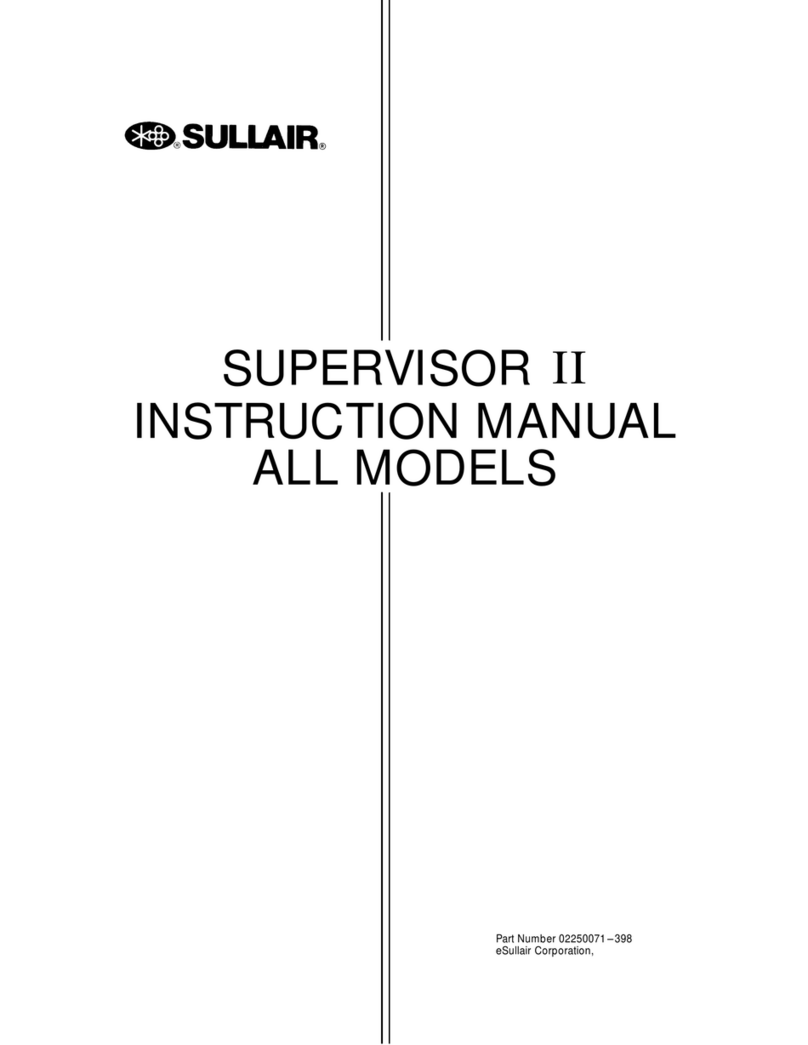
Sullair
Sullair Supervisor II User manual

Sullair
Sullair 02250160-842 User manual
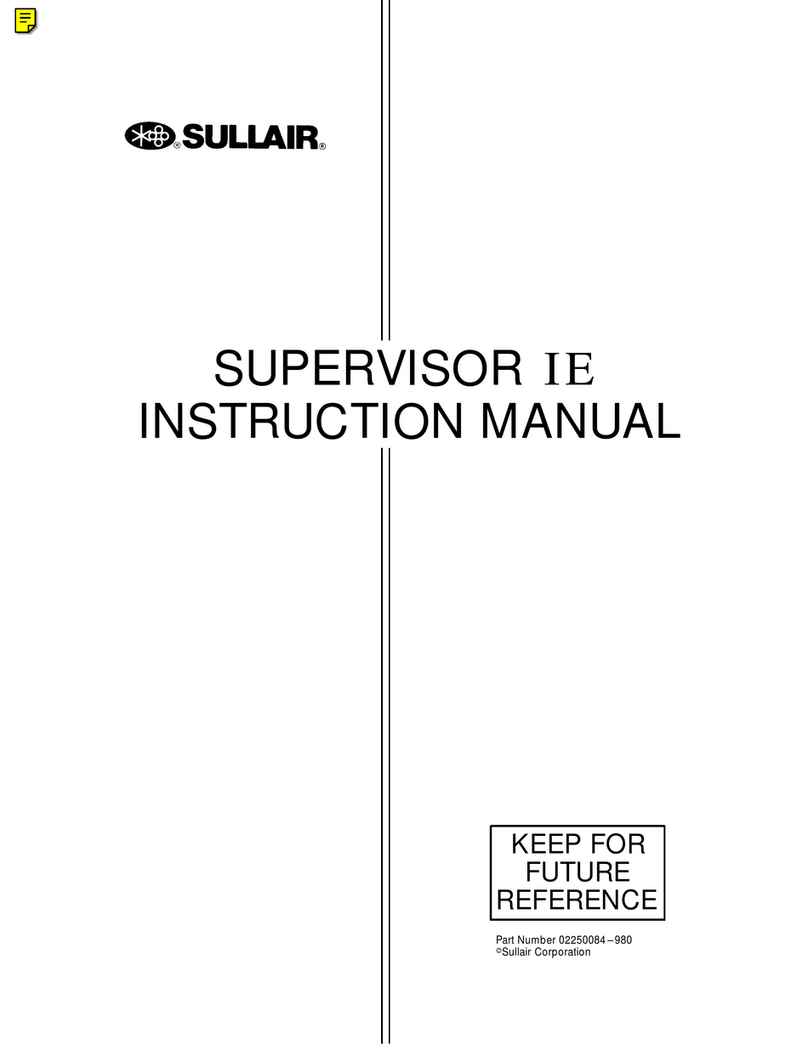
Sullair
Sullair Supervisor IE User manual
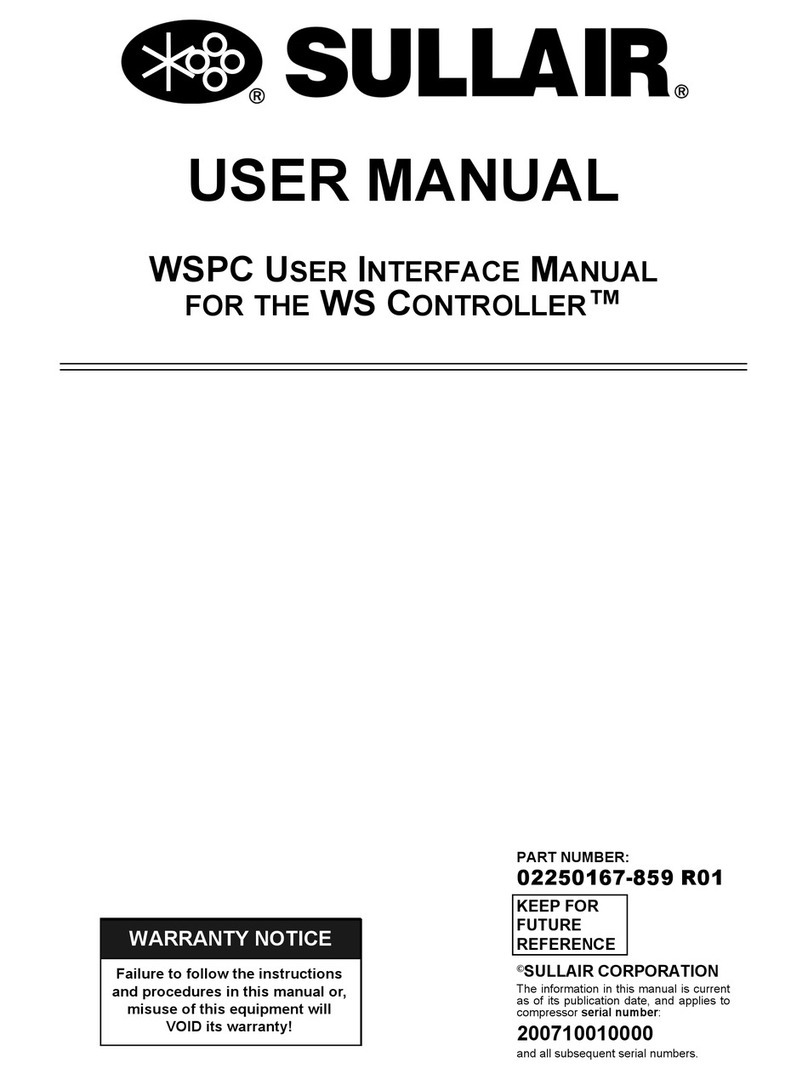
Sullair
Sullair WSPC User manual
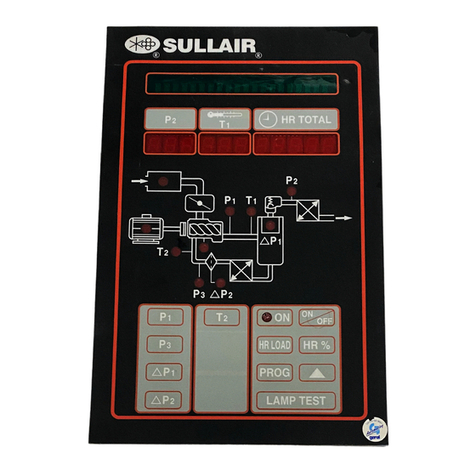
Sullair
Sullair SUPERVISOR CONTROLLER User manual
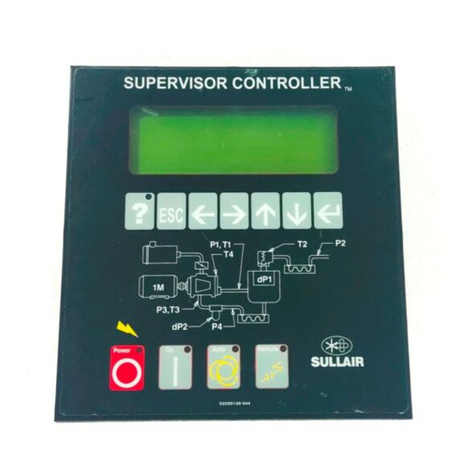
Sullair
Sullair SUPERVISOR CONTROLLER Series User manual

Sullair
Sullair 900 User manual
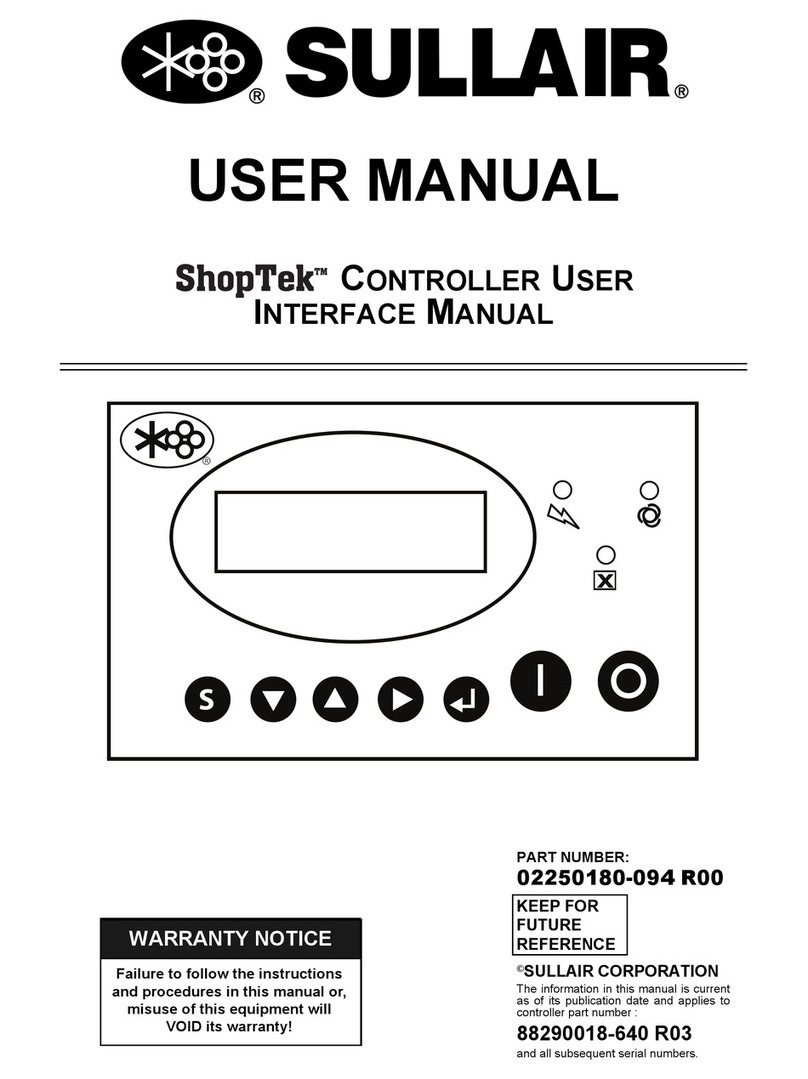
Sullair
Sullair ShopTek User manual
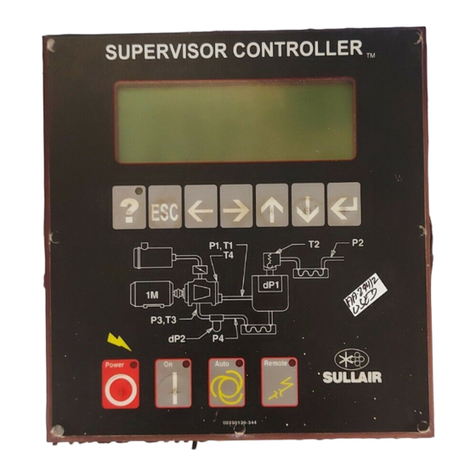
Sullair
Sullair SUPERVISOR CONTROLLER User manual
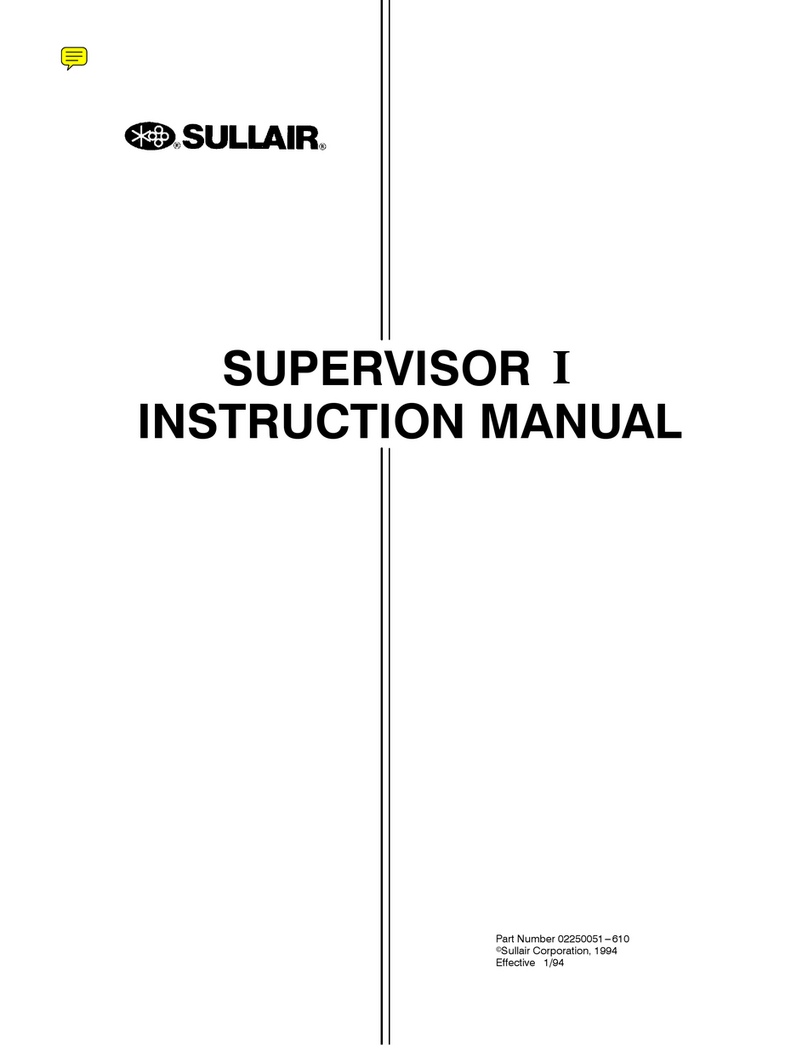
Sullair
Sullair SUPERVISOR I User manual


